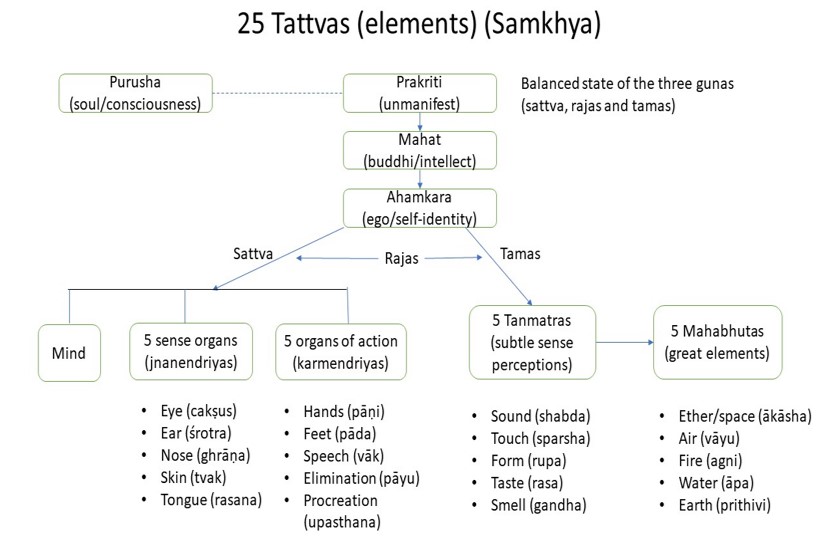प्रकृतेर्महान्, ततोऽहङ्कारः, तस्माद्गणश्च षोडशकः ।
तस्मादपि षोडशकात् पञ्चभ्यः पञ्च भूतानि ॥ २२ ॥
prakṛtermahān, tato’haṅkāraḥ, tasmādgaṇaśca ṣoḍaśakaḥ ।
tasmādapi ṣoḍaśakāt pañcabhyaḥ pañca bhūtāni ॥ 22 ॥
prakṛteḥ=from Prakriti; mahān=mahat (intellect); tataḥ=from that; ahaṅkāraḥ=ego; tasmāt=from that; gaṇaḥ=group of; ca=and; ṣoḍaśakaḥ=sixteen; tasmāt=from that; api=again; ṣoḍaśakāt=of the sixteen; pañcabhyaḥ=from the five (tanmatras); pañca=five; bhūtāni=great elements
From the Primordial Prakriti evolves the intellect (mahat or buddhi), from that evolves the ego, from there the set of sixteen; from the five (tanmatras) out of these sixteen, the five great elements evolve.
In karika #21 we saw that the purpose of the union between purusha and prakriti is for the sake of attaining kaivalya (liberation) of the purusha as well as for the creation to take place. The present karika explains the sequence of evolution starting with the unmanifest prakriti first creating the intellect (buddhi) followed by all the elements (tattvas) all the way to the five gross elements.
The word ‘tattva’ literally means ‘that-ness’ implying the true essence of any object. The 23 elements enumerated are thus the basic elements of prakriti. The word prakriti is a composite of kṛti (कृति) with the prefix pra. kṛti means a creation or something that has been made. The prefix pra could be interpreted as ‘prior to’ or ‘preceding’ giving the meaning that nothing comes before it and it is the source for all. Another interpretation is based on pra implying ‘prakṛṣṭa’ in Sanskrit which means ‘the best’. In that sense the meaning would be ‘an excellent creation’. Another word for prakriti that has been used in the SK is ‘pradhāna’ which literally means an entity that contains all that’s created from it.
In the scheme of evolution, the first element that comes from prakriti is ‘mahat’ which literally means ‘great’ and is a synonym for the intellect (buddhi). From buddhi comes ahamkara (ego). From the ego comes the group of sixteen – the mind, five sense organs, five organs of action and the five tanmatras (subtle sense perceptions). From each of the five sense perceptions are produced the five gross elements (bhutas).
The evolution chart presented above shows all the elements with names in English and Sanskrit.

Leave a Reply